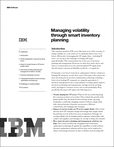The supply chain is facing volatility on a scale and level of complexity almost never seen before.
IBM has recently released a new white paper covering the latest developments in inventory optimization technology, including a look at how leading consumer products companies use next generation inventory management tools to minimize working capital, improve inventory positioning and management, redesign network stocking nodes, and improve customer service and overall profitability.
To learn more about smart inventory planning strategies for evolving your supply chain, get your copy of this informational whitepaper free from IBM.


